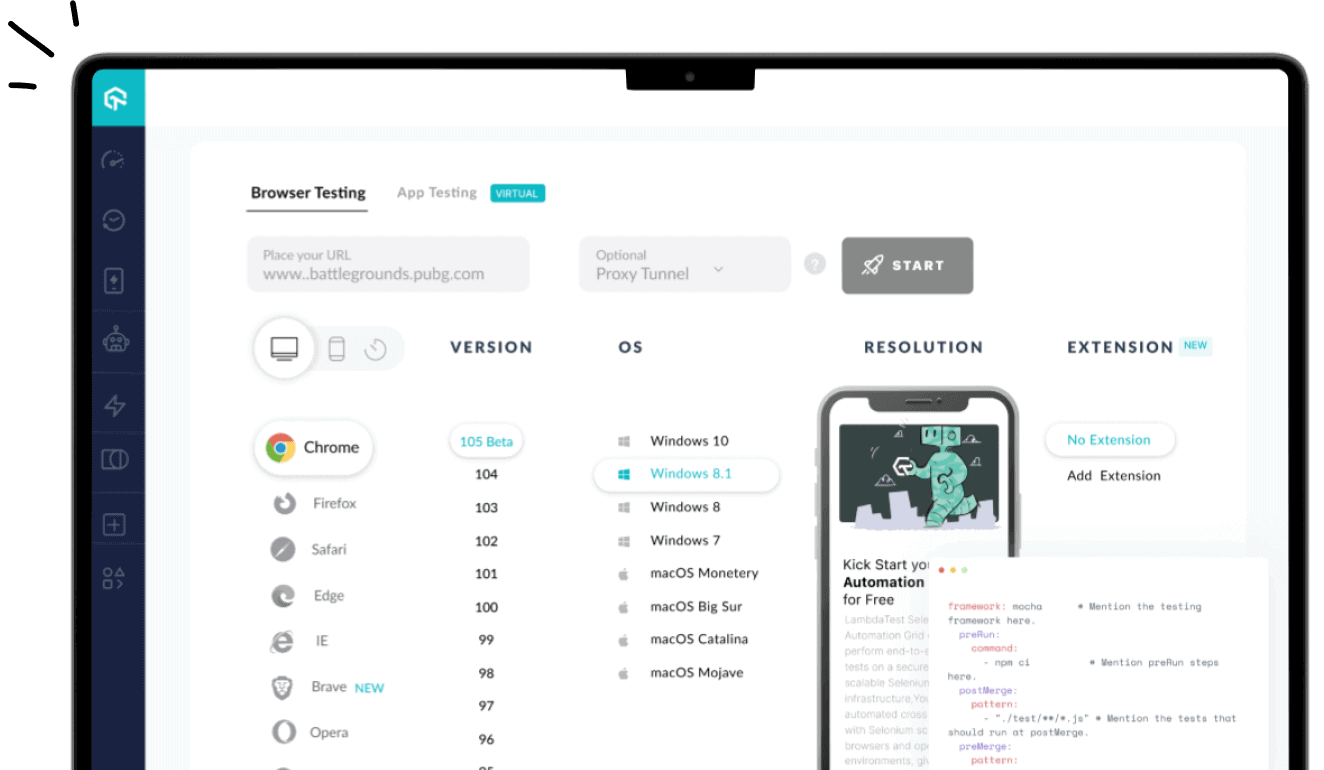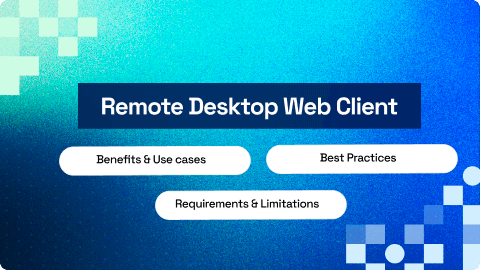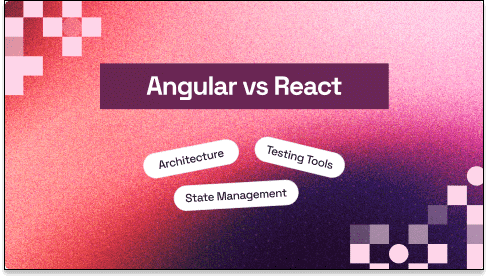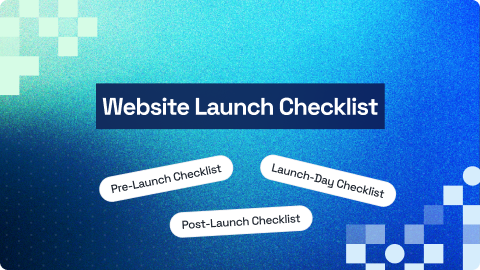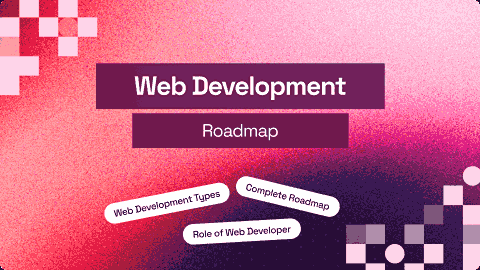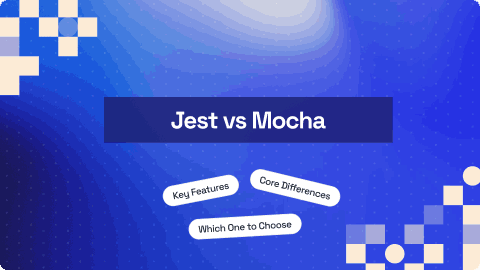The 17 Best JavaScript Frameworks for Web Development and Testing in 2026
Mehul Gadhiya
Posted On: November 18, 2025
28 Min
JavaScript frameworks are essential in modern web development, providing you with structured ways to build dynamic, interactive, and maintainable applications. They simplify complex tasks such as UI rendering, state management, routing, and server-side logic, allowing you to focus on functionality instead of building common features from scratch.
By leveraging some of the best JavaScript frameworks, you can accelerate development, ensure consistent code quality, and create scalable solutions for front-end, back-end, and testing purposes. Understanding the strengths and purposes of different frameworks helps you choose the right one for your project requirements.
Overview
What Does a JavaScript Framework Do?
A JavaScript framework acts as a development blueprint, handling much of the underlying complexity so developers can focus on features rather than setup. It coordinates how components, logic, and data interact, making it easier to build dynamic, interactive applications efficiently.
- Provides a Standard Application Structure: A JavaScript framework delivers prebuilt patterns and structures, helping developers start projects quickly without reinventing core architecture.
- Simplifies Common Development Tasks: It offers tools to create, update, and manage reusable UI components, reducing manual DOM manipulation and improving consistency.
- Offers Built-In Tools and Utilities: Frameworks organize how features, state, and logic are handled, ensuring predictable behavior as applications evolve.
- Improves Developer Productivity: They manage navigation and page transitions efficiently, enabling fluid single-page application experiences.
- Ensures Consistency Across Teams: Frameworks simplify connecting to APIs, authentication services, and databases, enabling smooth front-end and back-end communication.
- Supports Testing and Debugging: With built-in optimizations, best practices, and structured workflows, frameworks help maintain clean, efficient, and scalable applications.
What Are Some of the Best JavaScript Frameworks for Front-End Development?
Modern front-end development relies on powerful JavaScript frameworks that simplify UI creation, streamline state handling, and improve browser performance. These tools offer reusable components, optimized rendering, and structured workflows that help teams build fast, scalable, and interactive user experiences.
- React: A component-driven library enabling flexible UI development with a virtual DOM and a vast ecosystem for building dynamic interfaces.
- Vue.js: A lightweight framework combining clarity and power, offering reactive data handling and simple integration for both small and large projects.
- Ember.js: A convention-focused framework delivering stability, strong routing, and opinionated structure ideal for complex, long-term front-end applications.
- Preact: A compact React alternative providing fast rendering, minimal footprint, and high compatibility for performance-critical front-end development.
- Svelte: A compiler-based framework converting components into optimized JavaScript, delivering fast rendering and minimal runtime overhead in production.
What Are Some of the Best JavaScript Frameworks for Back-End Development?
Back-end JavaScript frameworks provide the foundation for building servers, APIs, and full-stack applications with efficient routing, data handling, and performance optimizations. These tools streamline backend workflows, reduce boilerplate, and help developers create scalable, maintainable server-side architectures.
- Node.js: A runtime environment enabling fast, event-driven server applications using non-blocking I/O and a massive ecosystem of reusable modules.
- Next.js: A full-stack framework offering server components, API routes, and hybrid rendering to build dynamic, production-ready applications efficiently.
- Express: A minimalist web framework providing flexible routing, middleware layers, and a lightweight foundation for building scalable REST APIs and services.
- Koa.js: A modern backend framework using async functions to simplify middleware flow, delivering cleaner code and improved error handling capabilities.
- Hapi.js: A configuration-centric framework offering powerful validation, authentication, and plugin architecture designed for secure, enterprise-grade backend solutions.
- Meteor.js: A full-stack platform enabling real-time application development with integrated data syncing, build tools, and shared code between client and server.
What Are the Core Differences Between JavaScript Frameworks and Libraries?
JavaScript libraries provide reusable tools, while frameworks define structure and control the application’s flow. The key distinction lies in how much control each gives you over the application’s flow, design patterns, and development decisions.
- Control Flow: Frameworks manage application structure automatically, while libraries let developers directly decide how and when functions run.
- Application Structure: Frameworks enforce organized patterns for building features, whereas libraries provide utilities without dictating overall design choices.
- Development Workflow: Frameworks streamline tasks through preset conventions, but libraries require manual decisions for architecture, setup, and implementation.
- Feature Integration: Frameworks include built-in systems like routing or state handling, while libraries rely on external tools for expanded functionality.
- Scalability Approach: Frameworks support large applications with consistent practices, while libraries scale flexibly but need disciplined structure from developers.
TABLE OF CONTENTS
- What Does a JavaScript Framework Do?
- JavaScript Frameworks for Front-End
- JavaScript Frameworks for Back End
- JavaScript Frameworks for Testing
- Picking the Right JavaScript Framework
- Front-End Framework Considerations
- Back-End Framework Considerations
- JavaScript Testing Framework Considerations
- JavaScript Frameworks vs Libraries
- Frequently Asked Questions (FAQs)
What Does a JavaScript Framework Do?
A JavaScript framework provides developers with a structured foundation for building web applications more efficiently. Instead of writing all functionalities from scratch, these frameworks offer predefined patterns, tools, and architecture that simplify development while improving consistency and scalability.
- Provides a Standard Application Structure: JavaScript frameworks supply a clear, organized structure for managing files, components, and business logic. This makes it easier to maintain and scale applications as they grow in complexity.
- Simplifies Common Development Tasks: Frameworks automate repetitive and essential tasks such as updating and rendering the UI, handling user interactions, managing data flow, navigating between pages through built-in routing, and integrating APIs and services.
- Offers Built-In Tools and Utilities: Most frameworks include utilities for templating, state management, form handling, code optimization, and performance enhancement right out of the box.
- Improves Developer Productivity: By providing ready-made solutions and reusable components, frameworks help developers work faster and more efficiently, allowing teams to focus on application logic rather than low-level setup.
- Ensures Consistency Across Teams: JavaScript frameworks enforce conventions and best practices, ensuring that codebases remain organized and predictable, especially beneficial for large teams or long-term projects.
- Enhances Performance and Scalability: Optimized rendering, modular architecture, and efficient data handling allow applications built with frameworks to perform smoothly and scale without major refactoring.
- Supports Testing and Debugging: Many frameworks integrate seamlessly with testing libraries and development tools, making it easier to debug code, write maintainable tests, and ensure application reliability.
7 Best JavaScript Frameworks for Front-End Development
Front-end frameworks provide the structure and tools needed to build dynamic, interactive web applications efficiently. JavaScript front-end frameworks help developers manage UI components, handle state, and implement responsive designs while maintaining maintainable and scalable code.
Selecting the right framework enables faster development, smoother user experiences, and seamless integration with back-end services.
Below are some of the best JavaScript frameworks shaping modern front-end development.
1. React
React is a popular JavaScript library for building fast, interactive, and component-driven user interfaces. Designed by Meta, it focuses on efficiently rendering dynamic UI elements using a virtual DOM and a declarative programming style. This JavaScript framework enables developers to build reusable components, manage complex state updates, and create scalable front-end architectures for modern web applications.
Key features:
- Component-Based Architecture: Structures applications using reusable components that isolate logic and UI into organized building blocks.
- JSX Syntax: Enables writing markup-like structures directly inside JavaScript files for clearer and unified component definitions.
- Virtual DOM Rendering: Updates the UI efficiently by calculating minimal changes using an in-memory virtual representation.
- Unidirectional Data Flow: Moves data in one direction to maintain predictable component communication and easier state tracking processes.
- Hooks API: Adds state, lifecycle control, and side effects to functional components without requiring class structures.
- Context API: Shares global data across components without relying on deeply nested prop passing chains.
- Rich Ecosystem Support: Integrates smoothly with routing, state management, and build tools for structured application development workflows.
Learn more about testing React applications through this React testing tutorial.
2. Vue.js
Vue.js is an open-source JavaScript framework designed to build user interfaces through an approachable, component-based architecture. It focuses on simplicity and flexibility, allowing developers to incrementally adopt features such as reactivity, templating, routing, and state management. With its lightweight core and intuitive design, this JavaScript framework enables teams to create fast, maintainable, and scalable front-end applications across a wide range of project sizes.
If your application is built with Vue.js, you can strengthen its quality by exploring this comprehensive guide on Vue.js testing, which covers key techniques and best practices for testing Vue.js projects.
Key features:
- Reactive Data Binding: Responds to data changes instantly by updating the UI using an efficient reactivity system.
- Component-Based Design: Encapsulates templates, logic, and styles into independent reusable components.
- Single-File Components: Combines markup, script, and style within one file for simpler component management.
- Directives System: Uses directives to apply dynamic DOM behaviors directly within template structures.
- Computed Properties: Generates derived values automatically based on reactive data dependencies.
3. Ember.js
Ember.js is an open-source JavaScript framework designed for building large-scale, ambitious web applications with a strong emphasis on stability and convention. It provides a structured project architecture, a powerful routing system, and a unified tooling ecosystem that supports development, testing, and build processes. With its opinionated patterns and steady updates, Ember.js ensures predictable workflows and long-term maintainability, making Ember testing an essential part of achieving high application quality.
Key features:
- Convention over Configuration: Establishes a predictable application structure using strong conventions that reduce decision-making and configuration needs.
- Ember CLI Tooling: Supplies powerful command-line tooling for building, testing, generating, and maintaining application components efficiently.
- Routing Engine: Handles sophisticated navigation flows required by large single-page applications with deeply nested route structures.
- Data Layer Support: Integrates Ember Data to manage models, relationships, and API communication in a unified data layer.
- Template-Based UI: Uses Handlebars templates to create declarative user interfaces with minimal embedded logic.
4. Preact
Preact is a lightweight JavaScript framework designed to deliver fast performance while maintaining a familiar, component-driven development model. It offers a similar API to React, enabling developers to build interactive interfaces with minimal overhead and easy migration. Its compact size and efficient rendering engine make it well-suited for projects where speed and footprint are critical, such as mobile sites, embedded widgets, or performance-sensitive applications.
Key features:
- Compact Core Size: Provides essential component functionality in an extremely small codebase optimized for high performance.
- React-Compatible API: Supports many familiar React patterns, enabling straightforward reuse of components with minimal modification.
- Virtual DOM Implementation: Updates user interfaces efficiently using a highly optimized and lightweight virtual DOM system.
- Component Lifecycle Hooks: Offers structured lifecycle methods that give developers precise control over component rendering behavior.
- JSX Support: Enables writing component templates using JSX, allowing clear and expressive UI structure definitions.
5. Svelte
Svelte is an open-source JavaScript framework that shifts most of its work to compile time, generating highly optimized JavaScript during the build process. Instead of relying on a virtual DOM, Svelte updates the UI through direct, fine-grained DOM operations, resulting in faster runtime performance and smaller bundle sizes. Its component-first architecture, built-in reactivity, and minimal boilerplate make it well-suited for applications where efficiency, clarity, and maintainability are priorities.
Key features:
- Compiler-Based Rendering: Compiles components into highly optimized JavaScript that eliminates runtime virtual DOM processing entirely.
- Reactive Assignments: Automatically triggers UI updates whenever reactive variables change using simple assignment-based reactivity rules.
- Scoped Styling: Applies styles only to the specific component, preventing unintended visual effects on surrounding interface elements.
- Stores System: Provides small, efficient reactive stores to manage shared application state consistently across components.
- Optimized Bundle Output: Generates compact, performance-focused bundles aimed at fast loading times and efficient runtime execution.
6. Alpine.js
Alpine.js is a lightweight open-source JavaScript framework designed to add interactivity directly in HTML using simple, expressive attributes. It enables developers to build reactive components without complex tooling, making it ideal for enhancing static pages or server-rendered applications. With its minimal footprint and declarative syntax, Alpine.js delivers many of the capabilities of larger frameworks while staying close to the simplicity of traditional HTML.
Key features:
- Declarative DOM Control: Adds dynamic interface behavior using simple, attribute-based directives written directly within standard HTML markup.
- Reactive Data Objects: Automatically updates visible UI elements whenever associated reactive data values inside component scopes change.
- Minimal Setup: Runs instantly in the browser with no compilation, bundling, or build tools required for functionality.
- Component-Like Structures: Creates lightweight, isolated interactive sections by grouping state and behavior within HTML element scopes.
- Event Handling Directives: Manages user-triggered actions using concise event-related directives directly attached to HTML elements.
7. Mithril
Mithril is an open-source JavaScript framework used for building single-page applications with a fast virtual DOM and minimal complexity. It includes essential features like routing and state management out of the box, enabling developers to structure applications without large dependencies. Known for its small size, predictable architecture, and straightforward API, this JavaScript framework is well-suited for dashboards, admin panels, and performance-focused web apps.
Key features:
- Lightweight Architecture: Delivers essential single-page application capabilities within a compact library designed for fast performance and minimal overhead.
- Virtual DOM Engine: Efficiently updates interface elements using a streamlined virtual DOM system optimized for rapid rendering operations.
- Built-In Routing: Provides a flexible, integrated routing mechanism that handles navigation without requiring external libraries or additional configuration.
- Built-In AJAX: Offers simple, built-in methods for sending API requests and managing asynchronous application data flows.
- Component-Driven Design: Organizes application structure using concise, functional components that define both logic and rendering behavior.
6 Best JavaScript Frameworks for Back-End Development
Modern web applications rely on robust back-end frameworks to handle server logic, APIs, and database interactions efficiently. JavaScript back-end frameworks enable developers to build scalable, high-performance applications using a single language across both front-end and back-end.
Choosing the right JavaScript framework helps streamline development, simplify routing, manage data effectively, and integrate seamlessly with front-end technologies.
Below are some of the leading frameworks powering today’s server-side JavaScript applications.
1. Node.js
Node.js is an open-source, server-side JavaScript runtime built on Chrome’s V8 engine, enabling developers to build scalable backend applications using JavaScript. Its non-blocking, event-driven architecture makes it highly efficient for handling concurrent connections, real-time data flow, and network-intensive workloads. The npm ecosystem further enhances its capabilities by supporting APIs, microservices, and enterprise solutions, along with a variety of tools that streamline Node.js unit testing for improved code quality.
Key features:
- Event-Driven Architecture: Utilizes an asynchronous event loop, allowing high-volume operations to be processed efficiently without thread-based blocking behavior.
- V8 JavaScript Runtime: Executes server-side JavaScript using Google’s optimized V8 engine, providing consistent performance and predictable environment capabilities.
- Native Module System: Organizes backend logic into reusable CommonJS or ES modules supporting structured application development across various codebases.
2. Next.js
Next.js is an open-source React-based framework that supports building full-stack applications with server-side rendering, API routes, and dynamic data handling. It provides a unified environment where frontend and backend logic coexist, enabling developers to create performant web apps with optimized loading, routing, and server-side processing. Its file-system routing, built-in API layer, and integration with modern deployment platforms make it a strong choice for scalable production applications. Next.js is ideal for production environments.
To ensure application reliability, our in-depth guide on Next.js testing covers essential techniques for testing Next.js projects.
Key features:
- Decorator-Based Syntax: Uses TypeScript decorators to define controllers and services, enabling consistent, structured, and maintainable backend application architectures.
- Dependency Injection Container: Manages service dependencies automatically, improving module organization and enforcing strong architectural consistency within application components.
- Modular Application Design: Groups related functionality into cohesive modules, enabling scalable system growth and clear logical boundaries throughout complex projects.
3. Express
Express.js is a fast, minimalist, and open-source backend framework for Node.js designed to build web servers and APIs with a simple, flexible structure. It provides robust routing, middleware support, and HTTP utility methods, enabling developers to handle requests, manage sessions, and structure application logic efficiently. With its lightweight architecture and extensive ecosystem, this JavaScript framework serves as the foundation for many modern REST APIs, microservices, and server-side applications. If you’re using Express.js in your application, understanding Express testing is essential for ensuring your routes, middleware, and APIs work as expected.
Key features:
- Middleware Pipeline: Processes incoming requests through stacked middleware layers offering structured request handling and customizable server behavior patterns.
- Routing Framework: Defines application routes using flexible methods enabling organized endpoint grouping for complex backend structures and API designs.
- Template Engine Integration: Supports multiple view engines, enabling dynamic HTML generation directly from server-side scripts in structured rendering workflows.
4. Koa.js
Koa.js is a lightweight, open-source backend JavaScript framework created by the same team behind Express.js. It is designed to build scalable web applications and APIs using modern JavaScript features like async/await. This framework provides a minimal core with a robust middleware system, enabling developers to compose functionality modularly and handle requests and responses efficiently. Its flexibility and small footprint make it ideal for performance-focused, custom server-side solutions.
Key features:
- Async Middleware Flow: Uses modern async functions in middleware chains, allowing precise control over request and response handling throughout application logic.
- Minimal Core Foundation: Provides only essential HTTP features, encouraging developers to build servers through lightweight, modular, and composable middleware extensions.
- Context Object Abstraction: Centralizes request and response information into a single context object, simplifying access to HTTP interaction data efficiently.
5. Hapi.js
Hapi.js is an open-source, configuration-driven backend JavaScript framework for building scalable and maintainable web applications and APIs. It emphasizes a plugin-based architecture, allowing developers to encapsulate features and extend functionality modularly. Hapi provides powerful routing, input validation, caching, authentication, and request lifecycle management out of the box. Its structured design and built-in capabilities make it suitable for enterprise applications, REST APIs, and complex server-side systems.
Key features:
- Configuration-Centric Setup: Defines server behavior through structured configuration objects, providing predictable application behavior without manual routing complexity.
- Plugin Extension System: Encapsulates reusable functionalities into plugins, enabling organized feature distribution across large-scale backend applications.
- Integrated Request Validation: Uses schema-driven validation, ensuring incoming payloads meet defined structures before backend processing occurs consistently.
6. Meteor.js
Meteor.js is an open-source, full-stack JavaScript framework that enables rapid development of web and mobile applications. It provides a unified environment where the same codebase can run on the client and server, with real-time data synchronization between the two. This JavaScript framework includes built-in support for routing, database integration, and a package ecosystem, allowing developers to build reactive, scalable applications quickly. Its tight integration with MongoDB and DDP (Distributed Data Protocol) simplifies backend development and real-time communication.
Key features:
- Unified Full-Stack Environment: Combines client and server JavaScript into one system, offering synchronized logic across the entire application environment.
- Real-Time Data Layer: Automatically updates UI components through a shared data protocol, enabling synchronized state across clients and servers.
- Integrated Build System: Bundles client and server resources using a dedicated compiler, generating optimized artifacts for seamless deployment workflows.
4 Best JavaScript Frameworks for Testing
Effective JavaScript testing frameworks ensure code reliability, catch regressions, and validate application behavior consistently. The right testing frameworks help developers structure, write, and execute tests efficiently across front-end and backend environments.
Below are four widely used JavaScript testing frameworks that simplify automated testing workflows and enhance overall code quality.
1. Jest
Jest is an open-source JavaScript testing framework developed by Meta, designed for simplicity and reliability. It provides a zero-configuration setup, enabling developers to run unit, integration, and snapshot tests effortlessly. With its built-in assertion libraries, mocking tools, and parallel test execution, Jest streamlines modern testing workflows.
As one of the most popular testing frameworks for React applications, Node.js backends, and JavaScript projects, Jest offers a rich ecosystem and automatic test discovery.
If you’re just getting started, our Jest tutorial is a great place to learn how to write and structure effective tests using Jest.
Key features:
- Zero-Configuration Setup: Automatically detects tests and runs them without requiring initial configuration, simplifying test execution in new projects.
- Built-In Assertion Library: Provides native matchers and assertion methods to verify expected outcomes directly within test cases.
- Snapshot Testing: Captures serialized representations of components or data structures to compare against future test runs for consistency.
- Mocking and Spying Utilities: Includes tools to mock functions, modules, or timers, allowing controlled isolation of code during testing.
- Parallel Test Execution: Runs tests concurrently across workers to optimize execution time and improve the overall efficiency of large test suites.
- Code Coverage Reporting: Generates built-in code coverage metrics, showing lines, functions, and branches executed during test runs.
- Extensible Ecosystem: Supports plugins, custom reporters, and integrations with CI/CD pipelines for flexible and automated test workflows.
2. Mocha
Mocha provides a flexible environment for running both asynchronous and synchronous tests, making it easy to structure test suites. Developers can define hooks, organize test cases, and integrate with various assertion libraries, mocking tools, and reporters. Its adaptability makes Mocha.js testing a strong choice for teams that want the freedom to use their preferred tools while still maintaining consistent, reliable test execution across Node.js backends and browser-based applications.
If you’re looking to get started, our Mocha JS tutorial offers a clear introduction to writing and organizing tests with Mocha.
Key features:
- Flexible Test Environment: Supports asynchronous and synchronous test execution, enabling developers to structure test suites with full control.
- Hooks and Lifecycle Management: Provides before, after, beforeEach, and afterEach hooks for precise setup and teardown in test suites.
- Customizable Reporting: Integrates with multiple reporters to output test results in different formats for developer or CI consumption.
- Assertion Library Agnostic: Works with any assertion library, giving developers freedom to choose their preferred testing style.
- Modular Architecture: Supports plugins and extensions to enhance functionality and adapt the framework to project-specific requirements.
3. Jasmine
Jasmine is a unit testing JavaScript framework that enables developers to write behavior-driven tests with clean and expressive syntax, supporting both synchronous and asynchronous test cases. It comes with built-in matchers, spies, and utilities for mocking and assertions. Thanks to its structured approach to organizing test suites and specifications, Jasmine helps teams maintain clear and reliable test code.
If you are using the Jasmine framework for unit testing, follow this comprehensive Jasmine unit testing tutorial to get started with Jasmine.
Key features:
- Behavior-Driven Syntax: Uses descriptive, readable syntax for writing tests, supporting both synchronous and asynchronous code structures.
- Built-In Matchers: Includes a comprehensive set of matchers for asserting expected outcomes directly within test cases.
- Spies and Mocking Utilities: Provides tools to monitor function calls and mock objects or modules for isolated testing.
- Structured Test Suites: Organizes tests into clearly defined suites and specifications to maintain maintainable and readable test code.
- Support for Unit Testing: Designed for unit testing, allowing verification of isolated code behavior in both front-end and backend applications.
4. Karma
Karma is a JavaScript test runner that executes tests in real browsers, providing accurate feedback across multiple environments. It supports a wide range of plugins, preprocessors, and reporters, allowing teams to customize their testing workflows and integrate seamlessly with CI pipelines. Its automatic test re-execution on file changes ensures immediate feedback during development.
Key features:
- Real Browser Test Execution: Runs tests directly in multiple real browsers to ensure accurate validation across environments.
- Plugin and Preprocessor Support: Supports a wide variety of plugins and preprocessors to extend functionality and handle different file types.
- Automatic Test Re-Execution: Detects file changes and reruns tests automatically to provide immediate feedback during development.
- Customizable Reporting: Offers integration with various reporters to format test results for developers or continuous integration systems.
- CI/CD Integration: Seamlessly integrates with continuous integration pipelines to automate browser testing for modern development workflows.
How to Pick the Right JavaScript Framework?
Selecting the right JavaScript framework, whether for front-end, back-end, or testing, depends heavily on your project requirements, team expertise, and long-term maintenance goals.
Each framework offers unique patterns, tooling, and ecosystems, so aligning the choice with your application’s architecture and workflow is critical, and following JavaScript best practices can help ensure you make decisions that support scalability and maintainability.
Front-End Framework Considerations
Selecting the right front-end framework ensures your user interface is efficient, maintainable, and scales with your project’s growth. Evaluating interactivity, ecosystem support, and rendering requirements helps align the framework choice with your development workflow effectively.
- Project Complexity and Scale: Component-based frameworks like React, Vue.js, or Svelte are ideal for large applications, while Alpine.js suits lightweight projects.
- UI Interactivity Needs: Choose frameworks that provide reactive data binding, virtual DOM performance, or compile-time optimization based on interface requirements.
- Ecosystem and Tooling: Consider frameworks offering integrated state management, routing, testing utilities, and community support for efficient development.
- Browser Support & Compatibility: Ensure chosen frameworks function consistently across multiple browsers, including older versions, without breaking application behavior.
- SEO and Rendering Requirements: Frameworks with server-side rendering or static-site generation improve SEO, initial load speed, and content visibility.
- Accessibility Support: Use frameworks that simplify implementing ARIA attributes, keyboard navigation, and other accessibility best practices for all users.
- Animation and UI Libraries: Evaluate frameworks with robust UI component libraries, animation capabilities, or easy integration with external design systems.
Back-End Framework Considerations
Choosing the right back-end framework ensures scalable, secure, and high-performance server applications that integrate seamlessly with front-end systems. Framework selection should account for architecture, performance, database support, and developer familiarity to optimize maintainability and workflow efficiency.
- Application Architecture: Node.js with Express or Koa is ideal for microservices, APIs, and modular server-side application design patterns.
- Performance Requirements: Select frameworks that handle high concurrency, real-time data, and asynchronous operations efficiently without blocking the event loop.
- Integration Needs: Ensure compatibility with databases, authentication systems, and front-end frameworks to maintain consistent full-stack application functionality.
- Scalability & Load Handling: Frameworks should support horizontal scaling, clustering, and load balancing to handle increasing traffic effectively.
- Security Features: Consider built-in authentication, input validation, XSS/CSRF protection, and secure middleware for reliable application security.
- Middleware & Extensibility: Evaluate frameworks that allow modular extensions or plugins to add custom server-side functionality easily.
- API & Microservices Support: Use frameworks that simplify building RESTful APIs, GraphQL endpoints, or microservices with structured routing and logic.
JavaScript Testing Framework Considerations
Selecting the right JavaScript testing framework ensures reliable, maintainable, and automated verification of application behavior across all environments. Framework choice should align with project type, automation goals, team familiarity, and integration with CI/CD pipelines.
- Type of Testing: Choose frameworks suitable for unit, integration, end-to-end, or snapshot testing based on application requirements and scope. Selecting the right unit testing framework is especially important for ensuring reliable, isolated validation of individual components.
- Automation Capabilities: Frameworks with built-in mocking, spying, and parallel test execution streamline automated testing and continuous integration pipelines.
- CI/CD Integration: Select frameworks that integrate seamlessly with Jenkins, GitHub Actions, GitLab, or other CI/CD environments for consistent test execution.
- Cross-Browser Testing Support: For front-end applications, frameworks supporting multiple browsers ensure accurate validation across diverse user environments. Using a cloud-based testing platform can further enhance this by providing access to real browsers and devices.
One such platform is LambdaTest, which enables scalable cross-browser and cross-device testing without local setup. LambdaTest is a cloud testing platform that allows you to perform manual and JavaScript automation testing at scale across 3000+ browser and operating system combinations.
- Reporting and Analytics: Use frameworks that generate readable, machine-friendly reports with coverage metrics, test history, and actionable failure insights.
- Developer Familiarity: Choose testing frameworks that match your team’s experience to minimize onboarding time and reduce testing errors.
- Extensibility and Plugins: Frameworks offering plugins, custom reporters, and assertion libraries provide flexibility for complex or specialized testing workflows.
What Are the Core Differences Between JavaScript Frameworks and Libraries?
A JavaScript library provides reusable functions or utilities that developers can call when needed, giving them full control over how the application is structured. In contrast, a JavaScript framework offers a predefined architecture that dictates how your application should be built, helping streamline development for larger and more structured projects.
Below are the core differences between a JavaScript library and a JavaScript framework.
| Aspect | JavaScript Framework | JavaScript Library |
|---|---|---|
| Control & Flow (Inversion of Control) | Framework dictates the lifecycle and calls developer-written code via hooks, lifecycle methods, or configuration. | The developer directly invokes library functions, with full control of execution flow. |
| Architecture & Structure | Enforces architectural patterns (e.g., MVC in Angular, component-based structure in React/Next.js) for consistency. | No predefined architecture; developers choose patterns like MVC, MVVM, or functional components. |
| Rendering & DOM Management | Handles rendering cycles, virtual DOM diffing (React), reactivity (Vue/Svelte), or hydration (Next.js/Nuxt). | Typically performs isolated DOM operations (e.g., jQuery, Axios for HTTP calls). |
| Routing & State Management | Provides built-in routing, centralized state, and configuration-driven workflows (Angular Router, Ember Data). | Requires external libraries for routing (React Router) or state management (Redux, MobX). |
| Build & Tooling Ecosystem | Offers integrated build tools, CLI scaffolding, code generation, and dev servers (Angular CLI, Next.js CLI). | Minimal tooling; bundlers and compilers must be added manually (Webpack, Vite). |
| Testing Integration | Frameworks provide test utilities, mocks, or recommended setups (Angular TestBed, Next.js testing utilities). | Testing setup must be manually configured (Jest, Mocha, Testing Library). |
| Scalability & Maintainability | Highly scalable due to enforced conventions, folder structures, and standardized coding patterns. | Scales with added libraries but may lead to fragmentation without strict conventions. |
| Learning Curve | Broader ecosystem and deeper abstraction layers increase the learning curve but improve long-term maintainability. | Smaller API surface; simple to adopt for targeted tasks. |
Wrapping It Up!
Choosing the right JavaScript framework goes beyond trends, it’s about matching your project needs, architecture, and team skills with the right tool. Front-end, back-end, and testing frameworks each offer different strengths that help you build fast, maintainable, and scalable applications.
Whether you’re creating dynamic UIs with React or Svelte, building robust backends with Node.js or Express, or improving reliability with Jest, Mocha, or Jasmine, the goal remains the same: deliver high-quality software with minimal technical debt.
As the ecosystem continues to evolve, adopting strong development practices, embracing automation, and using cloud-based testing platforms like LambdaTest can further enhance consistency and performance across environments.
Choose the framework that fits your workflow and helps your team ship better software, efficiently and confidently.
Frequently Asked Questions (FAQs)
Have you built apps with Angular or another JavaScript framework?
Developers often build applications using Angular or other JavaScript frameworks because these tools provide pre-defined architecture, consistent patterns, and built-in features that streamline development. Angular, for example, offers a complete ecosystem with routing, dependency injection, and a CLI, making it suitable for large, structured applications. Other JavaScript frameworks like React, Vue, or Svelte offer more flexibility and lighter footprints, making them popular choices for projects where customization, performance, or rapid iteration is important.
Which JavaScript framework is best suited for ASP.NET: React, Vue, or Angular?
When integrating with ASP.NET, Angular is often preferred because it follows a strongly structured, opinionated architecture that aligns well with enterprise-grade .NET applications. React is also an excellent choice due to its component-based nature and ability to handle dynamic user interfaces efficiently. Vue offers simplicity and ease of integration, making it ideal for smaller ASP.NET applications that need a gentle learning curve. Ultimately, the best JavaScript framework depends on the size of the application, existing team expertise, and long-term maintainability goals.
What is the leading JavaScript framework today, and which one is most worthwhile to learn alongside Python?
The leading JavaScript framework today is React, primarily because of its massive community, extensive ecosystem, and component-based architecture that scales well across all types of projects. For Python developers, learning React or Vue is especially worthwhile, as both integrate smoothly with popular Python back-end frameworks such as Django, Flask, and FastAPI. React makes it easier to build highly dynamic, interactive front-end interfaces, while Python handles the backend logic and APIs. Vue is a great alternative if you prefer a simpler syntax and a more beginner-friendly learning curve while still maintaining strong integration capabilities with Python-based systems.
What is the best JavaScript framework for creating a blog?
For building a blog, the best JavaScript framework is often Next.js, because it supports server-side rendering and static site generation, both of which drastically improve SEO and page load speed. These characteristics are essential for blogs where indexing, performance, and content visibility matter. SvelteKit and Nuxt (Vue-based) are also strong contenders, offering fast rendering and lightweight output. The choice ultimately depends on the ecosystem you prefer, but any modern JavaScript framework with static generation can deliver an optimized blogging experience.
We still need the JavaScript framework included.
If a project requires explicitly including a JavaScript framework, the selection depends on the project’s architectural goals. Frameworks like React or Vue are ideal for modular, component-driven interfaces, while Angular suits applications needing strict conventions and large-team collaboration. Including a JavaScript framework adds structure, predictable state management, automated rendering cycles, and better long-term maintainability, especially in projects that will evolve over time.
Is the GitHub repository for the Dark Souls 3 cheat sheet a manual or does it use a JavaScript framework?
Most GitHub-based cheat sheet repositories for games like Dark Souls 3 are static documentation pages, meaning they function more like manuals rather than applications built using a JavaScript framework. However, some versions may incorporate lightweight frameworks such as Vue, Svelte, or React to add interactivity, filtering, or dynamic UI updates. Whether a JavaScript framework is used depends entirely on how the repository maintainers implemented the interface.
Is a JavaScript framework better suited for building a GUI without a backend system?
A JavaScript framework can absolutely be used to build a GUI without any backend system, as frameworks like React, Vue, Svelte, or even Alpine.js can generate fully interactive interfaces that run entirely in the browser. This client-only approach is ideal for dashboards, calculators, tools, documentation generators, and offline-first apps. The JavaScript framework handles state, rendering, UI updates, routing, and user interactions without needing a server-side counterpart.
Can you recommend a JavaScript framework for creating a CLI tool similar to Laravel’s Artisan tool?
For building a CLI tool like Laravel’s Artisan, a traditional JavaScript framework is not necessary because frameworks focus on UI rendering. Instead, the Node.js runtime provides modules like Commander.js, Oclif, and Inquirer.js that allow developers to create feature-rich CLI applications. While not frameworks in the UI sense, these tools act like JavaScript frameworks for command-line environments by providing structure, routing, and modular command handling.
Which JavaScript framework is better for SaaS, React or Vue?
Both React and Vue are excellent choices for building SaaS applications, but React is often preferred for larger, enterprise-scale products due to its mature ecosystem and extensive availability of state management, routing, and testing tools. Vue, on the other hand, is ideal for startups or fast-moving teams because it offers a simpler syntax, faster onboarding, and highly maintainable component design. The final decision depends on your desired development workflow and long-term scaling strategy.
What are the main reasons teams choose a JavaScript framework for modern web development?
Teams choose to use a JavaScript framework because it standardizes architecture, reduces boilerplate code, and provides tools for rendering, routing, state management, and testing. Frameworks like React, Vue, and Angular automate complex tasks such as UI updates, virtual DOM diffing, data flow handling, and API integration. By relying on a JavaScript framework, teams can deliver scalable, maintainable, and high-performance applications faster, especially across large codebases with multiple contributors.
Author

